Office Politics
Danish artist collective N55 want to rethink the office as a place for social cooperation rather than executive control, but have the 'imagination industries' beaten them to it? Craig Martin on the Office of the Future project
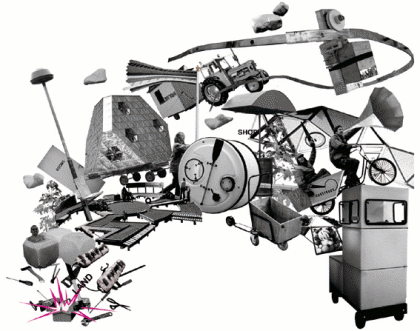 > OFFICE OF THE FUTURE, N55, 2004
> OFFICE OF THE FUTURE, N55, 2004
Since the diminution of specifically object-oriented practices within arts production, there has been an attempted re-categorisation of those sites where creative labour operates. This exercise in semantics has elicited a number of monikers plundered from other industries: ‘laboratory’ and ‘office’ are but two of the most widely used. These names suggest, somewhat over-simplistically at times, that there exists an unproblematic and ‘natural’ overlap between the working methodologies of scientific practice and service economies, and the sites of their production. One such recent example of this ‘re-naming’ process is THE OFFICE OF THE FUTURE by the Danish artist collective N55 and Parfyme. Set in a disused space in Copenhagen OFFICE offers a range of facilities, including: a factory; rooms for social activities; a café; herb garden; cinema and lecture theatre; an internal distribution system; radio station; as well as a protest rocket system. The latter of these facilities suggests a potential departure from the capitalist office environment. A further key element in OFFICE is KOMMUNE, a project by the group that proposes a ‘strategy’ (by way of furniture solutions) for communal living that can be initiated by members of the public. Such a reference to the potentially carnivalesque could seem to posit the office of the future as a site of liberated play, but given the so-called imagination industries’ predilection for ‘leisure zones’ in their actually existing offices perhaps ‘play’ isn’t quite as carthartic as we may think. With this in mind, N55’s OFFICE OF THE FUTURE sets out to investigate the function of the office space, and what it may become: ‘If there’s going to be offices everywhere, then we can just decide for ourselves what an office is.’ (N55, 2004) As a site of shared experience and open usage, OFFICE clearly isn’t your average office.
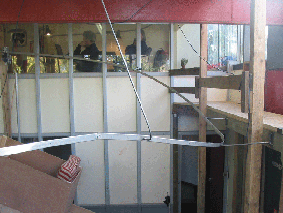 > 'Automatic Distribution System', OFFICE OF THE FUTURE, N55, 2004 .................The typical arts ‘lab’ elicits connotations of an experimental zone of activity, one not hindered by a pre-determined plan, but dependent on playful acts of admixture. Likewise, the sociology and psychology of the office space embodies the way that ‘today information and communication have come to play a foundational role in production processes.’ (Hardt & Negri, 2001:289) The concurrent shifts in artistic production toward the immaterial act point to the differentiated space of the contemporary office rather than the garret. The studio sits empty. However, practices that seek the studio’s ‘outside’ as a supposed critique of or potential safe-harbour from the tawdry discourse of their own activities, are often dependent on a blinkered reading of these other sites.
> 'Automatic Distribution System', OFFICE OF THE FUTURE, N55, 2004 .................The typical arts ‘lab’ elicits connotations of an experimental zone of activity, one not hindered by a pre-determined plan, but dependent on playful acts of admixture. Likewise, the sociology and psychology of the office space embodies the way that ‘today information and communication have come to play a foundational role in production processes.’ (Hardt & Negri, 2001:289) The concurrent shifts in artistic production toward the immaterial act point to the differentiated space of the contemporary office rather than the garret. The studio sits empty. However, practices that seek the studio’s ‘outside’ as a supposed critique of or potential safe-harbour from the tawdry discourse of their own activities, are often dependent on a blinkered reading of these other sites.
Robert Smithson, writing in 1968, stressed that, ‘deliverance from the confines of the studio frees the artist to a degree from the snares of craft and the bondage of creativity.’ (Smithson, 1996:107) ‘When the artist goes to the desert,’ Smithson added, ‘he enriches his absence and burns off the water (paint) on his brain.’ (Smithson, 1996:109) What then when the artist transposes production to the office? It may appear, at first, that the office space sits more comfortably with contemporary modes of networked artistic production, but this simple jettisoning of one site for another, does not address the fraught ideology of the office space itself.
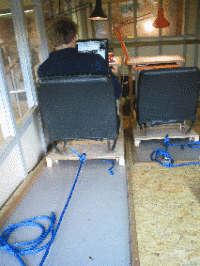 > 'Office', OFFICE OF THE FUTURE, N55, 2004.....................The biography of the office could be the biography of capitalism. Field, factory, office; this move from agrarian to tertiary economy, by way of the industrial, is told by its spaces of operation. (Hardt & Negri, 2001:280) Whilst the factory embodied the production ethic of the early twentieth century with its output of manufactured, material goods, the spatiality of the office was more redolent of the data-driven service market that it filtered. As a site the office offered a greater degree of ‘seduction’ to the worker, in its ‘softening’ of the factory regime. (Allen, 2003:146 & 149) Although the philosophies of management and efficiency differed little between the factory and the office (both being techniques that format the production of self), the realities at the corporeal level were vitally different. In more recent times the hierarchical embargoes of Taylorism – or so some would have us believe – have been eroded even further by the emergence of tele-working and flexitime. Although ‘for most of the twentieth century, offices were fixed in place’, in some dominant economies today this appears to be less the case. (Myerson, 2004: 201)
> 'Office', OFFICE OF THE FUTURE, N55, 2004.....................The biography of the office could be the biography of capitalism. Field, factory, office; this move from agrarian to tertiary economy, by way of the industrial, is told by its spaces of operation. (Hardt & Negri, 2001:280) Whilst the factory embodied the production ethic of the early twentieth century with its output of manufactured, material goods, the spatiality of the office was more redolent of the data-driven service market that it filtered. As a site the office offered a greater degree of ‘seduction’ to the worker, in its ‘softening’ of the factory regime. (Allen, 2003:146 & 149) Although the philosophies of management and efficiency differed little between the factory and the office (both being techniques that format the production of self), the realities at the corporeal level were vitally different. In more recent times the hierarchical embargoes of Taylorism – or so some would have us believe – have been eroded even further by the emergence of tele-working and flexitime. Although ‘for most of the twentieth century, offices were fixed in place’, in some dominant economies today this appears to be less the case. (Myerson, 2004: 201)
The image of office work offered to us now is one of mobility – working from home, operating on the move, and working to our own schedules through flexitime. (Laurier, 2004) Whilst it may appear that in the dissolution of barriers between office and home a greater flexibility exists, studies such as Richard Sennett’s The Corrosion of Character indicate otherwise: ‘A flextime worker controls the location of labour, but does not gain greater control over the labour process itself.’ (Sennett, 1999:59)
Although the image of Taylorised ‘drones’ may not be so visible in the economy of tele-working, the swipe cards that monitor the passage of labour time or the surveillance of electronic communications, index an evermore immanent form of control. Through decentralised technologies we return to centralised forms of control – the ubiquitous electronic umbilical of email. Work is ever present.
Similarly, in much of the immaterial labour of the culture industry and information economy, the lack of partition between work and non-work is evident. The very notion of a spatial division, sanctioned by the office, the street, or the home is not encountered. Rather, the ‘office’ leaks across all forms of social activity.
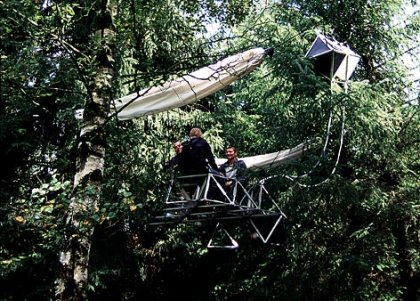 > SUSPENDED PLATFORM at LAND position: N 52° 18' 19,7" E 005° 32' 11,7". Zeewolde, The Nederlands, 2001
> SUSPENDED PLATFORM at LAND position: N 52° 18' 19,7" E 005° 32' 11,7". Zeewolde, The Nederlands, 2001
The adoption by N55 of the name, THE OFFICE OF THE FUTURE, may appear to fall into the trap of shifting the site of artistic production from the studio to what is, for a proportion of the populace, the dominant control mechanism of contemporary labour. But if one takes into account their previous work another, perhaps more promising reading of this project is possible. Stretching across N55’s activities since the mid-1990s has been the notional and actual dissolution of art into life, in the Soviet Productivist mode. This has been demonstrated through a variety of projects, including, SUSPENDED PLATFORM and SNAIL SHELL SYSTEM (www.n55.dk). Most tellingly, when one is considering the etymology of OFFICE, one of their largest projects to date provides a key link: N55 SPACEFRAME is a low-cost living space that the group constructed in Copenhagen. The very act of ‘dwelling as art’ may be one means by which to read OFFICE. But as suggested above, for sections of the main labour force the infiltration of work into their non-working lives is a form of immanent containment; for example, the residential architecture of the ‘live-work’ space is a constant reminder. For N55 the conflation of work and non-work seems to be based on their desire for a restructuring of everyday conventions through a reordering of all forms of social interaction, be they leisure or work.
They state that OFFICE is a space where ‘everyone can come and take part in building and using it’. (N55, 2004) On the other hand, the activities which they enumerate (eating, shitting, sleeping, working, meeting) do not really suggest a markedly or radically different usage than corporate office spaces. The ‘lived’ space (as Lefebvre put it) of the office is often a site of collective struggle, cupboard love and tainted use of labour time. Those activities that have so far occurred in OFFICE, including discussions about copyright, ownership of land, and film screenings on identity construction, do suggest a ‘theme’ to the project: the struggle for control over the individual. A possible problem here is that often this struggle seems merely to occur at the level of signification, as opposed to material change.
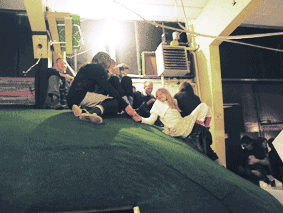 > 'Hill', OFFICE OF THE FUTURE, N55, 2004 ........................This brings us to N55’s use of ‘office’ as naming device. As with their gamut of other projects, such as ROOMS, LAND, FUND, SHOP, FACTORY, with OFFICE, designation and the re-calibration of an existing sign system is a pivotal, if gestural, element of the process. Naming itself simply becomes an internalised site of semiological struggle. Is the battle for symbolic production quite simply that: a semantic assault course? In the realm of corporate property speculation the power of reclassification and the suffix ‘future’ is often a facade for inflated prices.
> 'Hill', OFFICE OF THE FUTURE, N55, 2004 ........................This brings us to N55’s use of ‘office’ as naming device. As with their gamut of other projects, such as ROOMS, LAND, FUND, SHOP, FACTORY, with OFFICE, designation and the re-calibration of an existing sign system is a pivotal, if gestural, element of the process. Naming itself simply becomes an internalised site of semiological struggle. Is the battle for symbolic production quite simply that: a semantic assault course? In the realm of corporate property speculation the power of reclassification and the suffix ‘future’ is often a facade for inflated prices.
The ‘office of the future’ already appears to be in the grasp of those organisations that claim to have liberated their workers from the shackles of their desks. As suggested above, an element of subtle difference has already been injected into the working regime (table football, free flowing soft drinks, etc.), whilst actually tightening the ideological grip. One such ‘future office’ is British Airways' Waterside complex near Heathrow Airport. Housed within this utopian office complex are a library, ‘contemplative space’, supermarket, restaurant, florist and café, all reputedly broadening the scope of the workplace. (Myerson, 2004) Although N55 appear to desire an extension of the office to house more productive forms of social organisation, in light of such continual official attempts to reshape and refunction it this could seem a rather wishful project.
Not wanting to be defeatist, although there is potential in the OFFICE – based on an ideology of common usage and the construction of cooperation – contemporary capitalism’s own practice of ceaselessly resignifying and reclassifying its various institutions may prove all too difficult to disengage.
N55 http://www.n55.dk/OFFICE OF THE FUTURE http://www.fremtidenskontor.info/engversion/engindex.html
Sources:
Allen, J. (2003). Lost Geographies of Power. Oxford: BlackwellHardt, M. & Negri, A. (2001). Empire. Cambridge, Mass: Harvard University Press Laurier, E. (2004). ‘Doing Office Work on the Motorway’, Theory, Culture & Society, Vol.21, no.4-5. pp.261-277Myerson, J. (2004). ‘After Modernism: the Contemporary Office Environment’, McKellar, S. & Sparke, P. (Eds.) (2004). Interior Design and Identity. Manchester: Manchester University PressN55, (2004). http://www.fremtidenskontor.info/engversion/enginfo.htmlSennett, R. (1999). The Corrosion of Character: the Personal Consequences of Work in the New Capitalism. New York: NortonSmithson, R. (1996). ‘A Sedimentation of the Mind: Earth Projects’, Flam, J. (Ed.) Robert Smithson: Collected Writings. Berkeley: University of California Press
Mute Books Orders
For Mute Books distribution contact Anagram Books
contact@anagrambooks.com
For online purchases visit anagrambooks.com






